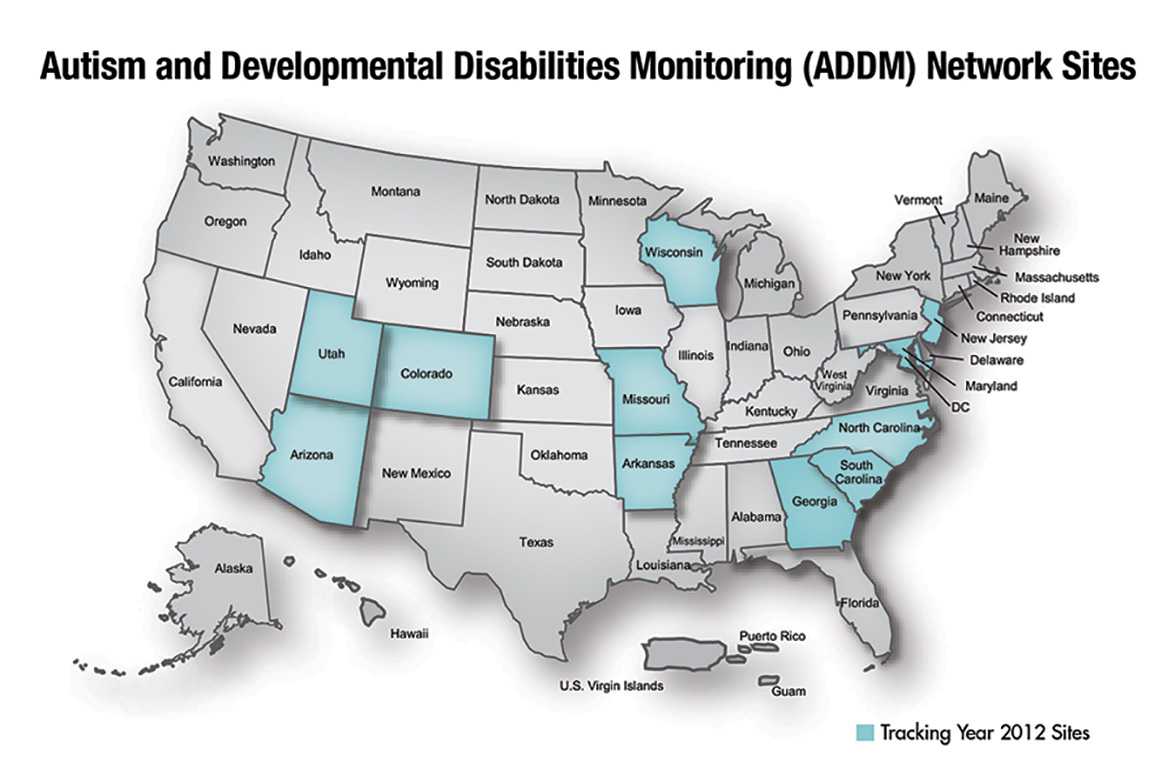Autism and Developmental Disabilities Monitoring (ADDM) Network

The Autism and Developmental Disabilities Monitoring (ADDM) Network is a group of programs funded by CDC to estimate the number of children with autism spectrum disorder (ASD) and other developmental disabilities living in different areas of the United States. The ADDM Network sites all collect data using the same methods, which are modeled after CDC’s Metropolitan Atlanta Developmental Disabilities Surveillance Program (MADDSP).
ADDM Network goals are to:
- Describe the population of children with ASD,
- Compare how common ASD is in different areas of the country,
- Identify changes in ASD occurrence over time, and
- Understand the impact of ASD and related conditions in US communities.
What We’ve Learned
CDC estimates that about 1 in 68 children has been identified with ASD (or 14.6 per 1,000 8-year-olds). These estimates from the ADDM Network are based on data collected from health and special education records of children living in 11 communities across the United States during 2012. These 11 communities comprised 8.5% of the United States population of 8-year-olds in 2012. Information was collected on children who were 8 years old because previous work has shown that, by this age, most children with ASD have been identified for services.
In 2007, CDC’s ADDM Network first reported that about 1 in 150 children had ASD (based on 2002 data from 14 communities). Then, in 2009, the ADDM Network reported that 1 in 110 children had ASD (based on 2006 data from 11 communities). And, in 2012, the ADDM Network reported that 1 in 88 children had ASD (based on 2008 data from 14 communities). In 2014, the ADDM Network reported that about 1 in 68 children had ASD (based on 2010 data from 11 communities). This means that the estimated prevalence of ASD increased roughly 123% during 2002 to 2010. However, the estimated prevalence of ASD stayed about the same between 2010 and 2012..

Here are some other key findings from our most recent report:
- The percentage of children identified with ASD ranged widely across geographic area. For example, in the areas where the ADDM Network reviewed both health and special education records, the percentage of children who were identified with ASD ranged from a low of 1 in 81 or 1.2% in areas of South Carolina to a high of 1 in 41 or 2.5% in areas of New Jersey.
- Boys were 4.5 times were more likely to be identified with ASD than girls.
- White children were more likely to be identified with ASD than black or Hispanic children. Black children were more likely to be identified with ASD than Hispanic children.
- Among children identified with ASD who had IQ scores available, about a third also had intellectual disability.
- About 43% of children identified with ASD were evaluated for developmental concerns by age 3 years.
- Black and Hispanic children were less likely to be evaluated for developmental concerns by age 3 years than white children.
- Even though ASD can be diagnosed as early as age 2 years, most children were not diagnosed with ASD by a community provider until after age 4 years.
Article: Prevalence and characteristics of autism spectrum disorder among children aged 8 years – Autism and Developmental Disabilities Monitoring Network, 11 sites, United States, 2012
Community Report: 2016 Community Report from the Autism and Developmental Disabilities Monitoring Network
Article: Prevalence of Autism Spectrum Disorder, 2010
Community Report: Read the Community Report on the 2010 ADDM Network findings
Current ADDM Network Activities
- In January 2015, CDC launched a 4th phase of funding for the ADDM Network. Read the announcement for more information.
- Currently, CDC funds 10 ADDM Network sites (plus MADDSP, which is the ADDM Network site administered by CDC).
- All 10 sites track ASD among 8-year-old children. Six sites also track ASD among 4-year-old children. Tracking among 4-year-old children increases our understanding of the characteristics and early identification of younger children with ASD.
- Some ADDM Network sites also track the prevalence of other developmental disabilities, including cerebral palsy, intellectual disability, hearing loss, and vision impairment.
- In addition to tracking, sites also conduct analyses of the data to better understand changes over time in the number of children identified with ASD, and carry out education and outreach activities in their local communities.

Read about the work taking place at each site by clicking one of the following links:
ADDM Fact Sheet.pdf [PDF – 975K]
Previous ADDM Network Activities
The ADDM Network’s first phase included funding for 14 sites. These sites include the current phase list above plus three additional sites. Read about the work at two of those former sites by clicking one of the following links:
ADDM Network Publications
To find ADDM publications related to ASD, visit our Autism Articles page. To find ADDM publications related to other developmental disabilities, including cerebral palsy, visit our Developmental Disabilities Articles page.
E-mail Your Friends
"Children with autism spectrum disorder are not being diagnosed as early as they could be. Learn the signs of autism and get help if you’re concerned."
Share on Facebook

“Many children with autism spectrum disorder (ASD) are not being identified as early as they could be. Early identification is the most powerful tool we have right now to make a difference in the lives of children with ASD.”
Share on Twitter
“Too many children w/ autism are not being identified as early as they could be. Earlier is better. #ActEarly”
- Page last reviewed: March 10, 2017
- Page last updated: December 5, 2016
- Content source:


 ShareCompartir
ShareCompartir